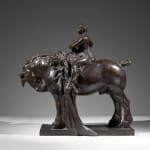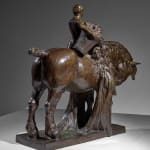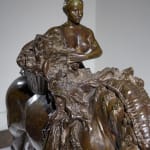Josuë Dupon
Further images
-
(View a larger image of thumbnail 1
)

-
(View a larger image of thumbnail 2
)

-
(View a larger image of thumbnail 3
)

-
(View a larger image of thumbnail 4
)

-
(View a larger image of thumbnail 5
)

-
(View a larger image of thumbnail 6
)

-
(View a larger image of thumbnail 7
)

-
(View a larger image of thumbnail 8
)

Josuë Dupon (Belgian, 1864 - 1935) was a very talented and productive artist. His body of work includes sculptures, medals, painting and graphic work. Although he did not aspire to be an innovator, he was familiar with all genres and mastered every technique and material. He was one of the first artists to begin carving ivory (in combination with gold and other materials) in 1893: his "Diana" (1897) was acquired by the Royal Museum of Fine Arts Antwerp .
He was an animalier pur-sang who was inspired by almost every animal species and had the talent to capture their specific anatomy as well as their character. This proves that Dupon was a true realist whose technical prowess, along with his dramatic sense of decorative complexity and slight tendency to idealize, was entirely in keeping with the 19th-century view of art.
Thanks to his older brother Karel Dupon , Josuë Dupon initially started in the studios of the neo-gothic sculptor and painter Clemens Carbon (1835-1907) and Modest Verlinden in Roeselare. He took evening courses at the academy in Roeselare and Antwerp (1884-1885); with Jozef Geefs (1808-1885) and Jacob De Braekeleer (1823-1906).
After successfully completing his studies (1885-1887) at the National Higher Institute of Fine Arts Antwerp (NHISKA) with Thomas Vinçotte (1850-1925), he won a first gold medal at the Salon of Antwerp in 1891 with his bronze group "Samson kills the lion," as well as the second prize for sculptures during the artistic competition Prix de Rome, from that year on, his work was displayed regularly at national and international exhibitions.
Dupon was also a member of several art societies: the Roeselaar Art Circle (1888), founded by his brother Karel, and De Scalden, a group of young painters, sculptors and architects in Antwerp who laid the foundation for l'Art appliqué (applied art).
After the Royal Museum of Antwerp bought his spectacular bronze group "Vulture defending its prey," the artist really began to build up a career.
He received official commissions for monuments and facade sculptures, received several important prizes and was appointed professor at the Antwerp Academy. The animalist Albéric Collin (1886-1962), the modernist sculptor Willy Kreitz (1903-1982) and the figurative sculptor Albert Poels (1903-1984) - who became highly renowned artists - studied under him.
Dupon became a respected and reputable authority whose work stood for high quality. His reputation as an animalist was confirmed when his bronze "Camel Driver" in 1901 and two bronze groups in 1903 were installed at the entrance to the Antwerp Zoo. His studio "De Reiger" in the Gulden Vlieslaan in Berchem (Antwerp) remained untouched until the death of his daughter in 1986.







